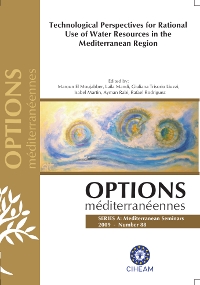| Article précédent | p. 199-205 | Article suivant |
Depuration of tannery effluent by phytoremediation and infiltration percolation under arid climate
The specific aims of this work were to investigate the potential of Phragmites australis to remove chromium from diluted tannery wastewater (50 percent) in comparison to unplanted soil, under arid climate conditions. Dilution is made by well water. The other aim was to study the treatment of raw tannery effluent by infiltration percolation system. The results indicated that during 13 months of experiment, total chromium undergoes an overall removal of 99 percent for the two plots, which provides limpid purified water. The results of the distribution of total chromium in the various strata of constructed reed bed indicated a significant accumulation of total Cr reaching 80 percent in the surface strata for two systems. Furthermore, the results showed that Cr could migrate also towards deeper levels of the soil. After 13 months of experiment, the soil accumulated high content of chromium: 94 percent and 98 percent for the planted and unplanted systems, respectively. However, 5 percent of Cr accumulated in Phragmites australis. The results also showed that Phragmites australis accumulated 1690 mg/kg dry matter of chromium in the roots. The study of the treatment of raw tannery wastewater by infiltration percolation system showed that, over seven months of experiment, the mean elimination rate for total chromium was 98 percent. The treatment of tannery effluent by reed bed combined with infiltration percolation system is a clean approach from an ecological point of view and constitutes a viable economic alternative in comparison to the purely chemical approaches for the treatment of tannery effluents.
Le but spécifique de ce travail est d'évaluer la capacité potentielle de Phragmites australis à éliminer le chrome des eaux usées de tannerie diluées (50 pour cent) par rapport au sol nu en climat aride. La dilution est réalisée en utilisant de l'eau de puits. Parallèlement, on illustre le traitement des effluents de tannerie bruts par infiltration-percolation. Les résultats indiquent que, sur les 13 mois d'expérimentation, le chrome total est éliminé à 99 pour cent dans les deux parcelles, ce qui permet de produire de l'eau épurée et limpide. A partir des données sur la distribution du chrome total dans les différentes strates de la roselière artificielle, on met en évidence une accumulation totale de Cr égale à 80 pour cent dans les strates superficielles des deux systèmes. De plus, les résultats montrent que le chrome pourrait migrer vers des couches plus profondes du sol. Au bout de 13 mois, le sol affiche une teneur élevée en chrome : 94 pour cent et 98 pour cent respectivement pour les systèmes avec ou sans lit de phragmites. Toutefois, 5 pour cent de Cr est accumulé dans Phragmites australis. Les résultats indiquent également que Phragmites australis accumule 1690 mg/kg de matière sèche de chrome dans les racines. L'étude du traitement des eaux usées de tannerie brutes par infiltration-percolation confirme que sur sept mois d'expérience, le taux moyen d'élimination du chrome total s'élève à 98 pour cent. Le traitement des effluents de tannerie en utilisant la phragmite associée à l'infiltration-percolation représente une approche propre sur le plan écologique et une alternative économiquement viable par rapport aux approches purement chimiques pour les effluents de tannerie.
- [ Afficher ]
- [ Télécharger ]
- [ Exporter la citation ]
Vous pouvez télécharger la citation au format :
- [ Imprimer ]
-
Mots-clés
BIOREMEDIATION, CHROME, EAU USEE, INFILTRATION, LESSIVAGE DU SOL, PHRAGMITES AUSTRALIS, TANNAGE, ZONE ARIDECiter cet article
Mandi L., Tiglyene S., Jaouad A. Depuration of tannery effluent by phytoremediation and infiltration percolation under arid climate. In : El Moujabber M. (ed.), Mandi L. (ed.), Trisorio-Liuzzi G. (ed.), Martín I. (ed.), Rabi A. (ed.), Rodríguez R. (ed.). Technological perspectives for rational use of water resources in the Mediterranean region. Bari : CIHEAM, 2009. p. 199-205. (Options Méditerranéennes : Série A. Séminaires Méditerranéens; n. 88). 2. MELIA Workshop Technological Perspectives for Rational Use of Water Resources in the Mediterranean Region, 2008/10/29-2008/11/02, Marrakesh (Morocco). http://om.ciheam.org/om/pdf/a88/00801195.pdf



